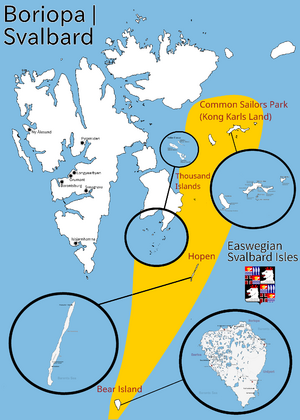Draft:Easwegian Svalbard Isles
 | Draft article not currently submitted for review.
This is a draft submission. It is not currently pending review. There are no deadlines as long as you are actively improving the submission. Drafts not being improved may be deleted after six months. Note: The submission-received box will appear at the top of the page. If it's there, your draft has been submitted correctly.
This draft has not been edited in over six months and qualifies to be deleted per CSD G13.
Where to get help
How to improve a draft
You can also browse MicroWiki:Good articles to find examples of MicroWiki's best writing on topics similar to your proposed article. Improving your odds of a speedy review
Last edited by Ezerryen (talk | contribs) 8 months ago. (Update) |
The Common Realm of the Easwegian Svalbard Isles, also known as the Easwegian Free Realm or the Realm of Easway, is a group of five island chains which serve as the Common Union of Easway's free realm, that is the area administered by the Co-operative Government, as opposed to the mainland Biarmian Displaced Territory. As an administrative division, it was established on 31 January 2024 and consists of the two united assembly areas of Bear Island and Pomoresia, which makes up 582 square kilometres. Its core cultural divisions are its four municipalities of Pomoresia, Essrina, Urdport, and its capital Boriopa Centrum, the latter three being located on Bear Island.
| Easwegian Svalbard Isles | |
|---|---|
| Also known as: Bear Island and Pomoresia | |
 | |
| Location | Barents Sea |
| Created by | 19 December 2017 - Easwegian independence on Bear Island 24 May 2020 - Hopen incorporation 1 January 2021 - Realm of Easway 1 August 2022 - current area 31 January 2024 - Biarmian Declaration |
| Areas | 582 square kilometres |
| Government | Government of Easway state, federated area, municipal and prefectural |
| Subdivisions | Bear Island Essrina Boriopa Centrum Urdport Pomoresia |
Background
Easway gained independence on Bear Island on 19 December 2017 under the direction of the Ouroboros' Serpents of Easway, led by Emizerri. It expanded to Hopen in 2020 and established it as Maritime Hopen (today known as Pomoresia) by early 2021, alongside the establishment of two commonwealths: Bear Island and the Pomors Frontier. These commonwealths were functionally unified by early 2023, and with the Biarmian Declaration, the Easwegian Svalbard Isles was established as the Easwegian-controlled area on 31 January 2024.
Administrative divisions
The Easwegian Svalbard Isles is made up of five island chains that are divided between the assembly areas of Bear Island to the south and Pomoresia to the east. There are four municipalities in Easway, 3 on Bear Island—Essrina, Boriopa Centrum, Urdport—and one contained within Pomoresia, named after itself—including its centre of Hopen island, and the nature reserves of the Thousand Islands and the Ryke Yse Islands. There is one national park located within the northeast of the Pomoresia assembly area, named the Common Sailors Park. Both Bear Island and Hopen are permanently inhabited, whereas the others have more strict visiting regulations.
Easwegian settlement of Svalbard
The settlement of Svalbard began in 1194 with its discovery first by Icelandic sailors of Papar Irish descent, who first discovered Bear Island and named it Iron Island. They then travelled north, reaching the tip of Spitsbergen and spotting the outlying Thousand Islands. Heading south, they returned to Bear Island, where they found that the Ezaari and Pomors had also just discovered the island after setting sail from Kola. The Icelandic sailors named the Ezaari-Pomors Austmenn 'Eastmen', which in Norse terminology referred to people of Scandinavia. This is the root of the modern term to refer to the nation of Easwegians. In the view of the Ezaari and the Pomors, both heavily influenced by ancient Greek mythology, they had stumbled upon the lands of Hyerborea, named after Boreas, God of the North Winds.
Government
The Easwegian Svalbard Isles is a dependent territory and represents the parts of Easway that are under all or somewhat influence by the Co-operative Government, and is directly administered by it. Unlike the Easwegian Biarmian commonwealths, the common realm does not have its own seperate executive government assigned by it, and thus the head of the Easwegian Svalbard Isles is the Grand Councillor, currently Squ Bai. The common realm does although maintain subdivisions with certain amounts of autonomous power, the most notable being the Bear Island and Pomoresia united assembly areas, which may influence legislative policy, and the four municipalities of Pomoresia, Essrina, Urdport, and the common realm's capital of Boriopa Centrum, the latter three located on Bear Island. Each municipality must contain at least three representatives who maintain a seat in the United Common Assembly, that is the Marquis and two prefects, therefore the Easwegian Svalbard Isles has guaranteed seats in national policy. Due to the Biarmian territory being displaced and not under the actual control of the Co-operative Government, the Easwegian Svalbard Isles is currently the sole policy maker for the Common Union.